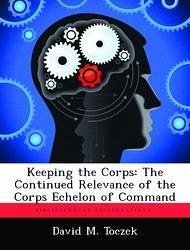Some decision makers and analysts believe that increased networking and technological advances have increased a commander 's span of control, thus allowing for an elimination of the US Army 's corps echelon of command. Aside from span of control and joint capabilities concerns, many see the elimination of the corps echelon of command as a means to help alleviate the Army 's manning concerns. While in most cases rational thought forms the basis for these possible courses of action, a theoretical construct against which to evaluate them seems lacking. This monograph develops a theoretical rationale for how and for which purposes the Army organized its corps headquarters over the past seventy years and evaluates the capabilities of current corps headquarters against an established set of criteria. This paper 's theoretical construct frames the issues surrounding the necessity of the US Army 's corps echelon of command in terms of complex, adaptive systems; organizational structure; decision making; span of control; and efficiency and effectiveness. This study concludes that although the current US Army corps headquarters do not completely fulfill the joint force attributes as articulated in the Defense Department 's Joint Operations Concepts, the document that outlines how the American armed forces will fight in the future, they do form an integral link between the present division and component commander headquarters. Summary elimination of the corps level of command at this time would place a tremendous burden upon both the echelons above and below and would place at risk operations employing multiple divisions or those requiring extensive planning efforts. Despite the continued requirement for this echelon of command, the US Army should structure its corps training program to focus upon the corps 19 role as potential joint task force (JTF) headquarters.
Hinweis: Dieser Artikel kann nur an eine deutsche Lieferadresse ausgeliefert werden.
Hinweis: Dieser Artikel kann nur an eine deutsche Lieferadresse ausgeliefert werden.








